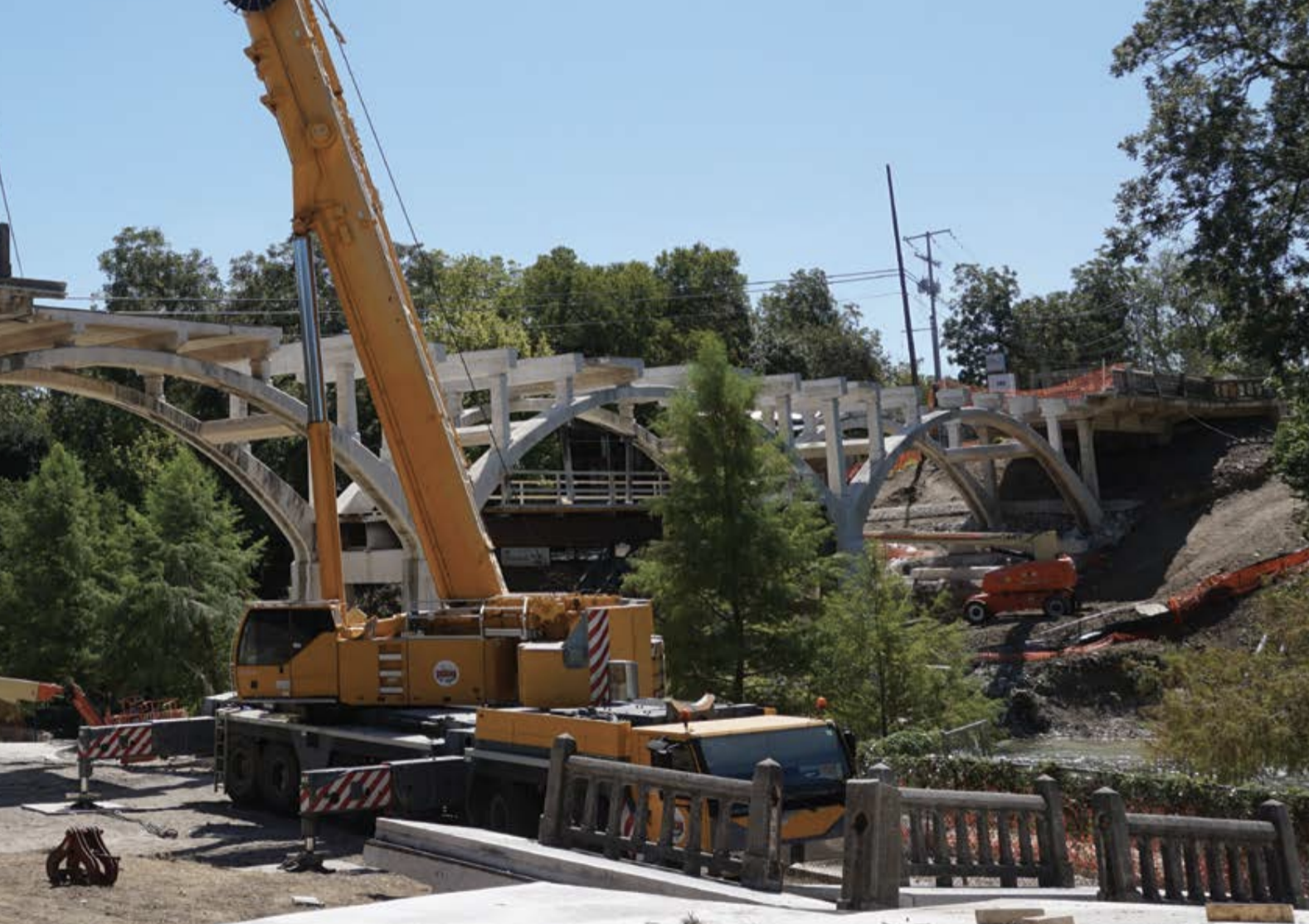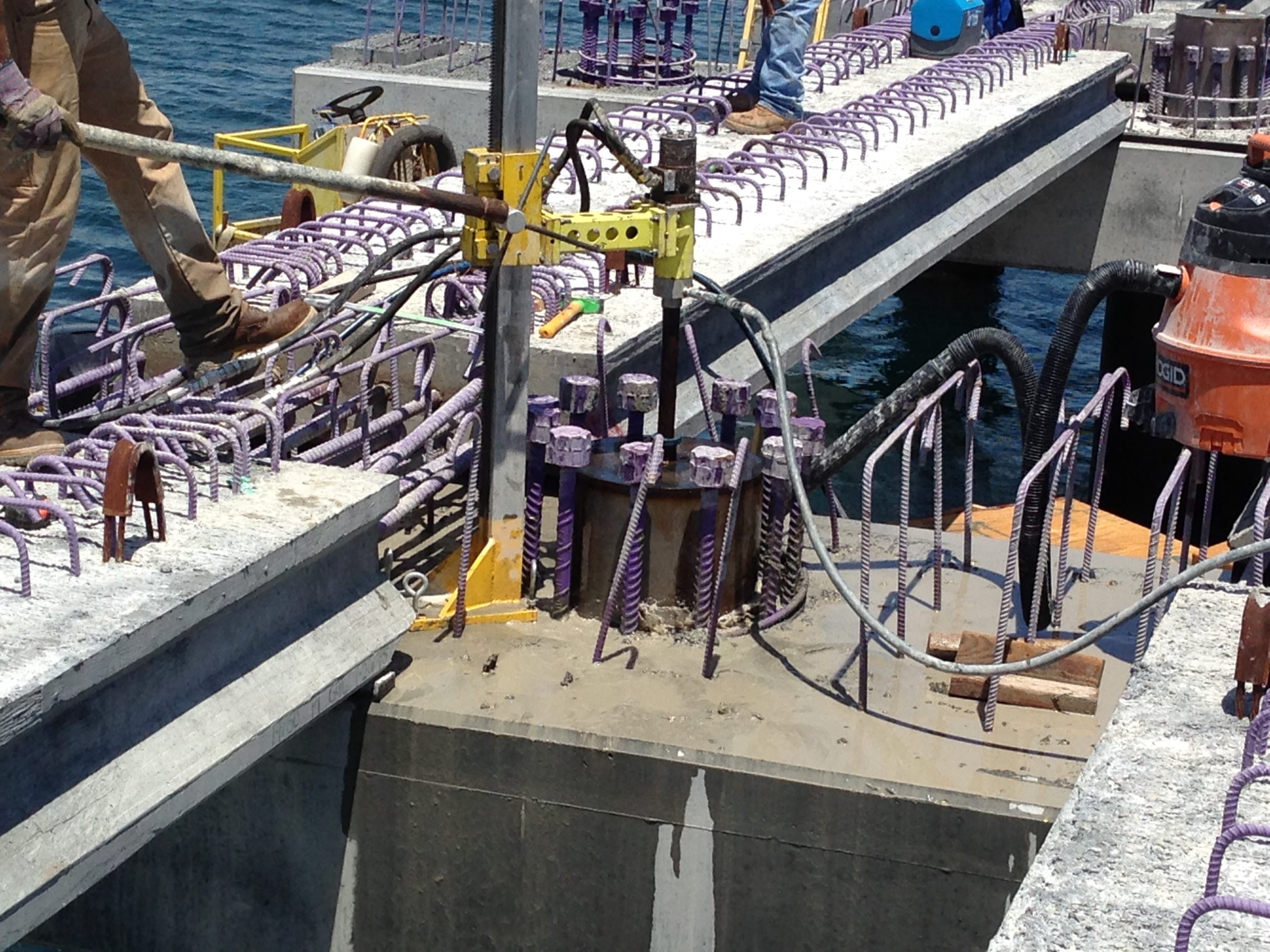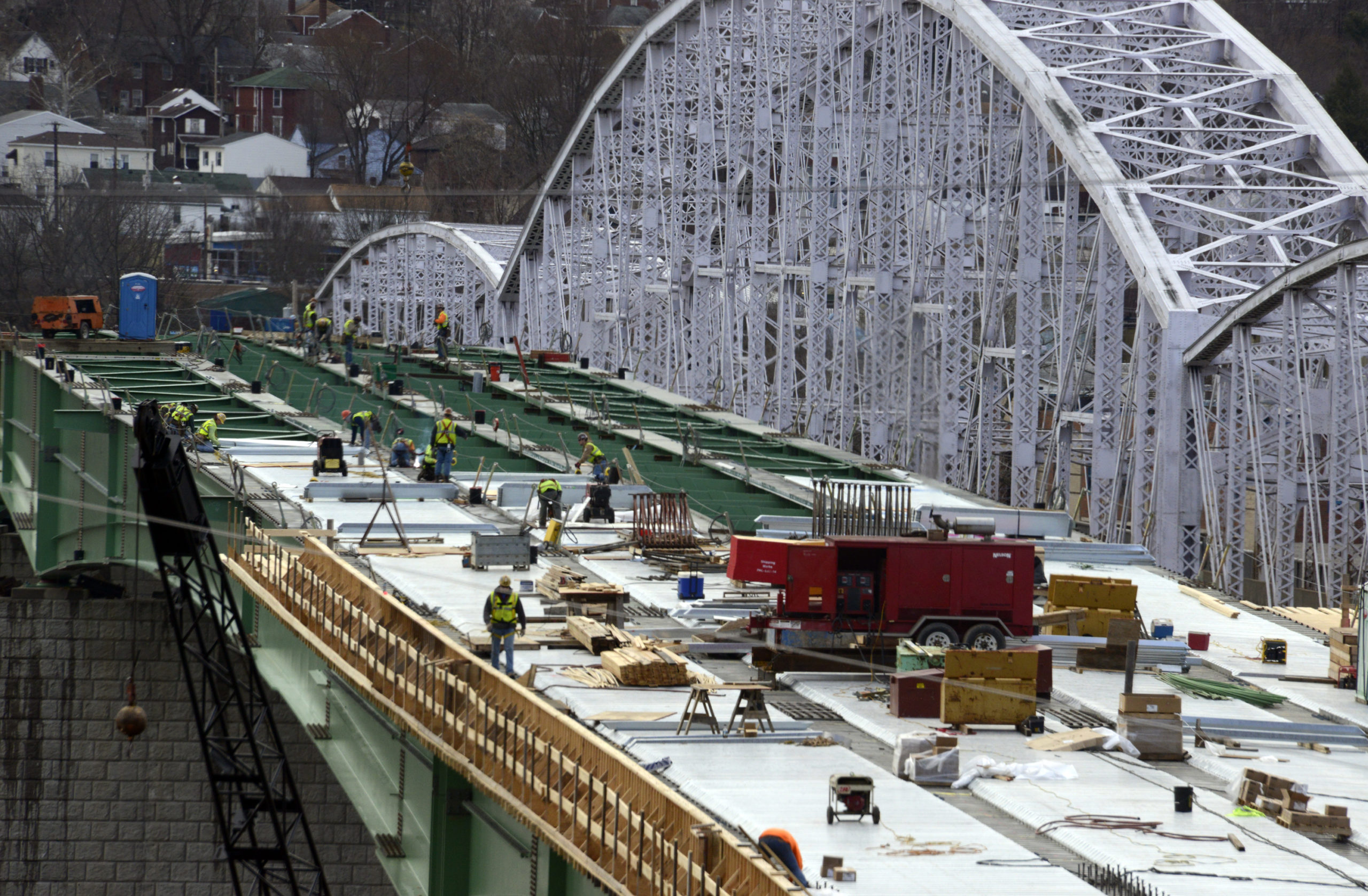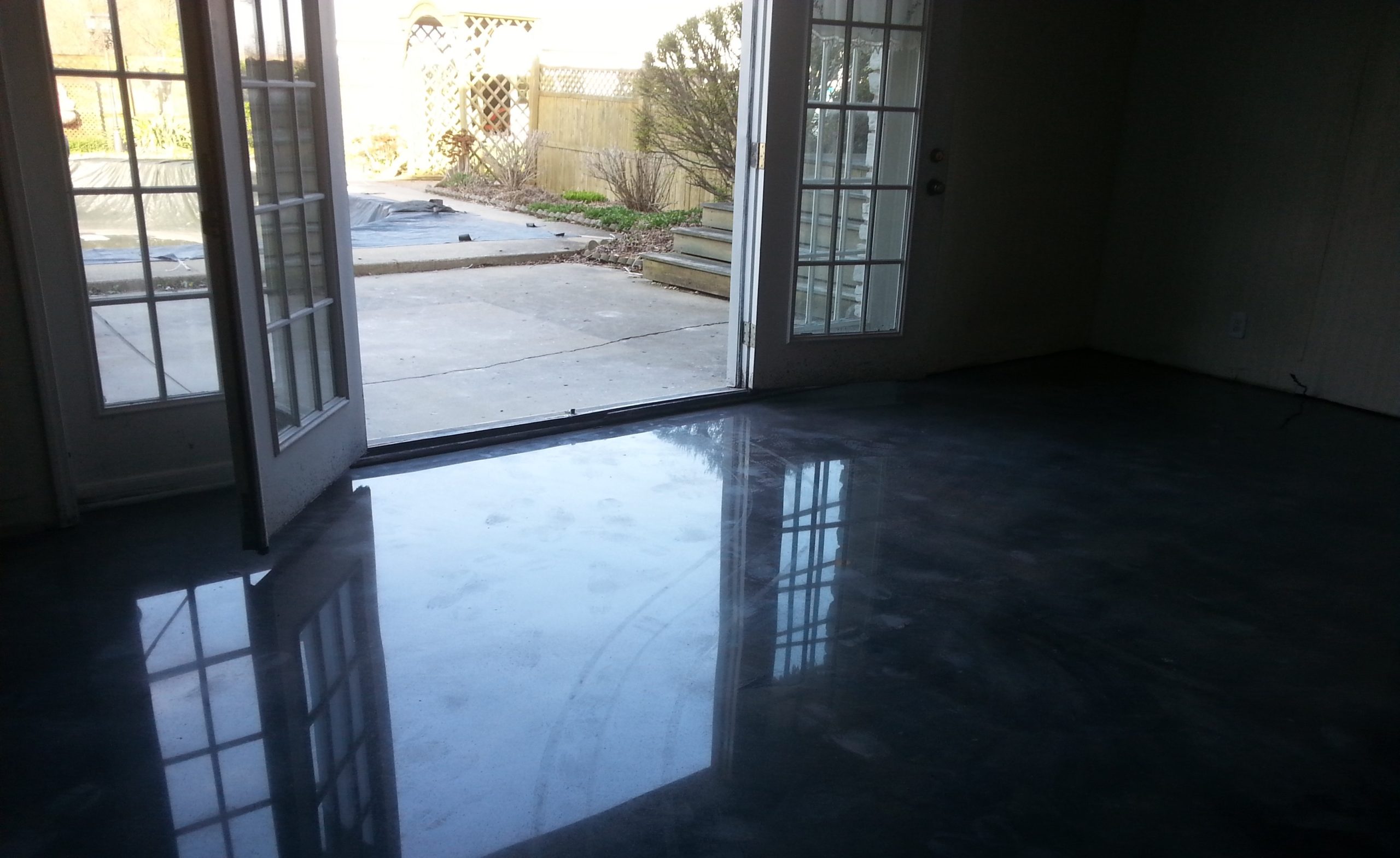
Popular Riverway Receives Upgrade from CSDA Contractor

The San Antonio Street Bridge on the Comal River in New Braunfels, Texas is a popular local destination. On any given weekend, hundreds of people tube down this scenic waterway, floating under the nearly 100-year-old bridge. Built in 1923, the aging historic bridge contained seven spans measuring 410 feet, but no longer met functional or structural standards. The lack of a shoulder for the 10-foot wide travel lanes and narrow, 4-foot sidewalks posed a safety risk for pedestrians and bicyclists and the 20,000-pound weight limit meant that heavier emergency response vehicles could not cross it. The Texas DOT and the City of New Braunfels planned a 16-month project to replace the superstructure of the bridge but leave the arches, spandrel columns and substructure in place, supported by concrete box beams. The superstructure would be widened to increase the width of each travel lane to 15 feet and each sidewalk to eight feet. The updated prefabricated deck would have a new weight limit of 50,000 pounds, capable of accommodating all types of emergency vehicles. The project was projected to cost $4.8 million. CSDA member Texas Cutting and Coring (TCC) was contracted by the job’s general contractor Capital Excavation to plan and execute the demolition of the deck, sidewalks, rails and beams. The planning phase was focused on a saw cutting and lift plan to calculate the weight of each bridge section to be removed by crane. The Texas DOT planned the average lift for the first phase at 20,000 pounds, plus the weight of the rigging. “Capital Excavation is a long-time customer of ours, and we have been working with them for the better part of 20 years. We know the senior leadership very well and have mutual trust, so it makes planning and executing complex REPRINTED FROM CONCRETE OPENINGS | VOL. 28 | NUM.4 | DECEMBER 2019 projects like this much easier,” stated Ronnie Wilhite of Texas Cutting and Coring. The San Antonio Street Bridge job posed many safety hazards. Care had to be taken during demolition and renovation as to not impact public safety, wildlife, river water or the city’s tourism revenue. The general contractor and the city oversaw public safety and suspended recreational traffic under the bridge. Before TCC started, the GC installed a temporary second deck below the bridge and 15 feet above the water to protect the public and the area below from falling debris. Strict safety guidelines had to be followed for worker safety due to the obvious fall hazards. Every crew member working on the leading edge of the bridge was required to wear harnesses and retractable lanyards with anchors. TCC met weekly with their crew to review safety procedures and advise them of what hazards they needed to be aware of.

TCC started demolition on September 25, 2019, removing nine to ten sections each day. In each planned lift section of the sidewalk and bridge deck, crews drilled four three-inch diameter core holes with Diamond Products Core Bore 744 four-speed core drills for lifting points. The rigging was done with Monkey Fists. Working from the south end of the bridge, TCC crosscut into the curb and across the sidewalks, making a total of 22 cuts four feet long each with a custom-built barrier saw and various walk-behind saws, including Husqvarna FS5000, FS6600, FS7000 and FS8400. They used saw blades from Diamond Products and DDM Concut including 18”, 24”, 30”, 36”, 42”, 48”, 54” and 60” diameters. To release the outside edge of the bridge from the structure, saw cuts were made with the same Husqvarna walk-behind saws at the face of the curb through the deck and bridge bents. These cuts had to be made in 20-foot sections, two at a time, for the length of the bridge. Walk- behind saws were again used to saw cut the asphalt and concrete deck away from the bridge bents as TCC worked their way off. Lifting the bridge sections was a challenge, as the south embankment was too steep to set up a crane beside or below the bridge. TCC looked to the southern bridge approach and set up a 550-ton crane, lifting sections of the deck over the water to a staging area below the bridge. Once they passed the halfway point, they switched to a 300-ton crane on the north embankment to remove the remaining decking and beams.

All the concrete was crushed for re-use in the temporary construction area below the bridge. The bridge bents were left in place, still attached to the columns as the work moved northward across the bridge. The columns were cut free with Diamond Products track mounted hydraulic wall saws with blades up to 36” and flush cut hydraulic hand saws with 20” blades made by Diamond Products and DDM Concut. After the deck was removed, the bridge bents were rigged and supported by the crane while they were cut free from the columns. TCC was on site for 22 days, but the actual deck demolition took ten. Tomas Acevedo, TCC general superintendent, oversaw the safety of the crew and daily operation of multiple saw cutting and coring crews of between two to eight employees, depending on the phase of the job. Acevedo coordinated with the general contractor to manage the equipment and crane use, as well as scheduling and production rates. He helped ensure that all safety protections were in place and were properly maintained during the demolition.d
COMPANY PROFILE
Texas Cutting and Coring was founded in 1997 and operates
over 40 trucks in their commercial division, employing
approximately 110 people. The main office is located in Austin,
with branches in San Antionio and College Station. They offer
the services of: Soffcut control joint sawing and sealing, full
depth slab sawing (electric and diesel), core drilling (electric and
diesel), wall sawing (electric and hydraulic), wire sawing (electric
and hydraulic), curb sawing, barrier wall sawing, concrete
demolition and haul off, robotic demolition, surface preparation
(sand blast, shot blast, floor grinding, milling), GPR scanning
and utility scanning. They specialize in bridge barrier and bridge
deck concrete sawing as well as structural concrete demolition.
They have been CSDA members since 2011.
RESOURCES
General Contractor
Texas Department of Transportation and the City of New
Braunfels
CSDA Cutting Contractor
Texas Cutting and Coring
Ronnie Wilhite
Phone: 210-637-6869 (O) / 512-689-0786 (M)
Email: ronnie@texascubcut.com
Methods Used
Slab Sawing, Core Drilling, Wall Sawing














